
What Happens When a Hydrocele Bursts?
Hydrocele is a common condition in newborns, affecting around 10% of male babies. It can also occur in adults. Although it might look serious, hydrocele disappears on its own and usually does not require treatment. However, seeing a urologist in Navi Mumbai is still advisable to rule out other serious issues that could have caused the swelling. Let’s learn more about this medical condition, its symptoms, and what happens when a hydrocele bursts.
What is a Hydrocele?
A hydrocele is a swollen scrotum (the pouch holding your testicles) caused by fluid accumulation. It can be caused by inflammation, infection, or any injury to the area. Most of the time, hydroceles are harmless and painless, although they can sometimes rupture and require medical intervention.
The most obvious symptom of hydrocele is painless swelling in the scrotum, which can make the scrotum feel heavier than usual. The doctor will conduct a physical exam to identify the cause of the swelling. They will ensure it’s not because of an inguinal hernia or an infection.
Possible Complications of a Burst Hydrocele
An underlying infection or excessive pressure on the swollen scrotum can sometimes lead to the sac rupturing, which can cause fluid leakage in the surrounding areas. This can cause symptoms like sudden throbbing pain in the scrotum and a softer scrotum after the sac bursts. There’s a risk of hemorrhage due to trauma, but that’s rare. If you suspect a ruptured hydrocele, seek immediate medical attention to prevent any life-threatening complications.
Treatment Options
1) Pain-Relief:
If there’s no sign of infection or any complication, your doctor will observe you. You can take over-the-counter pain-relief medication and use home remedies like cold compresses and keeping the scrotum elevated to minimize swelling.
2) Antibiotics:
If you develop an infection from a ruptured hydrocele, doctors may recommend a course of antibiotics to prevent the infection from spreading.
3) Surgical Options:
A minimally invasive procedure—needle aspiration—is used to remove the excess fluid. However, that offers temporary relief only. A more invasive surgery, called hydrocelectomy, is required if the sac bursts and does not heal or if the patient reports frequent ruptures and infection. This hydrocele treatment in Navi Mumbai is safe, although the recovery time can be longer (usually up to 2-3 weeks).
Preventive Measures
Hydrocele occurs due to injury, inflammation, or infection in the scrotum. You can follow preventive measures to prevent the fluid-filled sac from bursting. Here’s what may help:
a) Avoid Pressure:
Do not put any pressure or perform any strenuous physical activity that could cause trauma to the scrotum.
b) Get Treatment for Infections:
Infections can increase the risk of the sac bursting and lead to a widespread infection requiring immediate medical attention. Make sure you get immediate treatment for infection.
c) Watch Your Symptoms:
The warning signs of a burst hydrocele are pain and discomfort, as well as changes in the shape and size of the scrotum. See your doctor immediately if you experience pain, fever, chills, a discolored scrotum, or discharge. Early diagnosis and treatment are key to quick recovery, so get evaluated promptly if you notice the above signs.
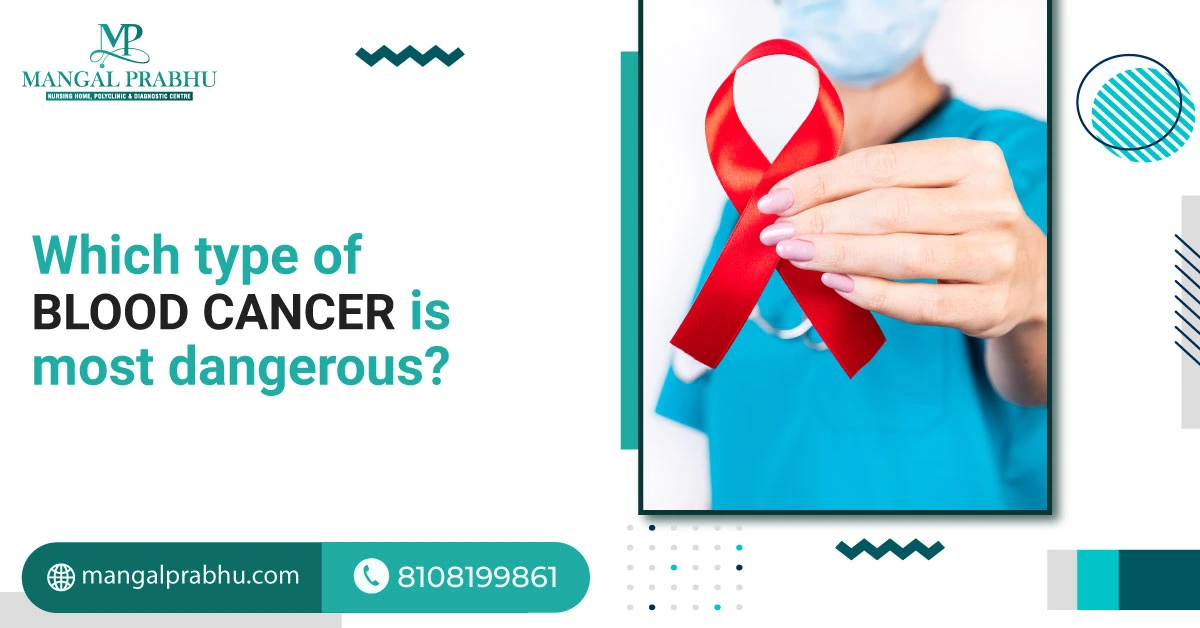
Which Type of Blood Cancer is Most Dangerous?
Blood cancer affects the bone marrow, blood cells, and lymphatic system, which are responsible for protecting the body from infections, circulating oxygen-rich blood throughout the body, and preventing bleeding. The cancer mostly begins in the bone marrow, the tissue that makes blood cells, and spreads to the lymphatic systems and the nearby organs.
Modern science has made certain types of blood cancer curable, including the ones labeled high-risk. However, it’s crucial to seek blood cancer treatment in Navi Mumbai as soon as you notice the symptoms. The success rate of the treatment depends on the aggressiveness of the disease, the type, and how far it’s spread.
Types of Blood Cancer
1) Leukemia:
Leukemia develops in the bone marrow, a spongy tissue responsible for making red blood cells, white blood cells, and platelets. Leukemia is a type of blood cancer that affects your white blood cells. It produces too many WBCs, leaving little room for other healthy blood cells to grow. Leukemia has further subcategories, depending on the type of WBCs affected and how fast it grows.
2) Lymphoma:
As the name suggests, Lymphoma affects your lymphatic system and the white blood cells responsible for fighting infections. In lymphoma, the cancer cells can start to grow in your lymph nodes, spleen, and thymus glands. It can also spread to other parts of the body, impairing your ability to fight off infections.
3) Myeloma:
Myeloma, or multiple myeloma, is a type of blood cancer that affects plasma cells, a type of white blood cells produced in the bone marrow. These cells are responsible for making antibodies, which fight infection. Myolema causes abnormal plasma cells to grow uncontrollably, leaving less room for the healthy cells to develop.
Most Dangerous Type: Acute Myeloid Leukemia (AML)
Many factors determine the danger level associated with blood cancer. However, many hematologists in Navi Mumbai believe that Acute Myeloid Leukemia (AML) is the most dangerous of all. Here’s why.
Among the three types of cancers listed above, the Acute Myeloid Leukemia is the most dangerous, as it spreads quickly to the brain, liver, and other vital organs, increasing the risk of organ failure.
Its aggressive growth is also linked to lesser production of healthy blood cells in the bone marrow. Even if the cancer is treated, acheiving a complete remission is quite challenging, especially in children, older people, and those with existing medical conditions.
Since the cancer spreads rapidly, the symptoms also appear quickly. You will notice increased bleeding, frequent infections, excessive fatigue, bone and joint pain, weight loss, and other relevant symptoms that become noticeable over days and weeks.
Treatment Options for Blood Cancer
The treatment includes chemotherapy with targeted therapy and stem cell transplant. The five-year survival rate for people with AML is 28%, although the numbers can vary depending on your age, health, how early the cancer is diagnosed, and if there’s any existing medical condition. Ideally, the sooner it’s detected, the higher the chances of a cancer-free life. Even if the treatment is succesful and there is no sign of cancer, your doctor will closely monitor you to ensure it doesn’t recur.
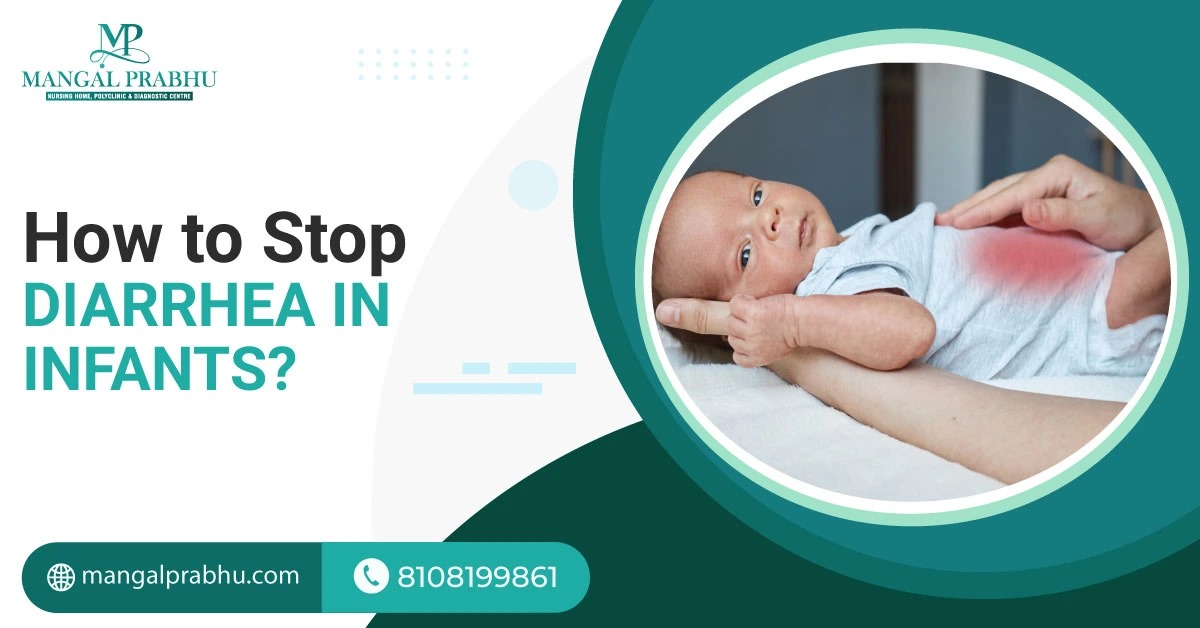
How to Stop Diarrhea in Infants?
Baby’s poop can be of different colors, textures, and odors, depending on their age and what they are eating (breastmilk, formula, or solids). It’s usually softer than an adult’s poop and can vary in frequency. However, if you notice stools that are too watery, loose, and more frequent than usual (three or more) in 24 hours, it could indicate diarrhea. Let’s check out the causes, symptoms, and treatment for pediatric diarrhea in Navi Mumbai.
Common Causes of Diarrhea in Infants
Here’s what may cause diarrhea in infants:
a) Viral Infections:
A viral infection is the most common cause of diarrhea in babies. Rotavirus and other viruses can spread easily by touching contaminated surfaces. Fortunately, vaccines are available for viral infections.
b) Bacterial Infections:
E. coli, Salmonella, and Shigella are common bacteria that can cause diarrhea with fever, stomach cramps, and vomiting in infants. Some are found in undercooked foods, and others may spread in certain environments, like daycare.
c) Food Allergies:
Your baby could be lactose intolerant or have a cow’s milk protein allergy. If they consume these foods or the breastfeeding mother consumes lactose-rich products, the baby could experience diarrhea.
d) Teething:
When infants start teething, they develop the habit of chewing on nearly everything they get. This can introduce germs to their mouth, leading to episodes of diarrhea. Teething also leads to excessive saliva production, which, when swallowed, can cause loose stools.
Recognizing Symptoms of Diarrhea
The most common symptom of diarrhea in infants is dehydration. It can happen pretty quickly (within 2-3 days or sooner) if the baby consistently passes loose, watery stools. Depending on the cause of the diarrhea, the parents might notice other symptoms, such as:
- Blood in the stools
- Vomiting
- Fever
- Abdominal pain
How to Stop Diarrhea in Infants? Home Remedies and Care Tips
Immediate care and medical attention (in severe cases) are required. However, these tips are often effective for mild diarrhea:
i) Adequate Hydration:
Continue offering breastmilk and formula to your baby to keep them hydrated. Breastfeeding provides many essential nutrients and antibodies that help your baby recover quickly. If required, you can offer a few sips of ORS to maintain the electrolyte balance and restore the lost fluid.
ii) Appropriate Dietary Adjustments:
Diarrhea can be a problem in babies who have just started solids. Adjust their diets by focusing more on applesauce, bananas, toast, and rice, which are lightweight on their digestive system. Avoid fruit juices and other sugary foods until their digestive health improves.
iii) Importance of Hygiene:
Diarrhea can lead to frequent diaper changes, which can cause a diaper rash. To avoid that, keep your baby’s genitals clean and dry. Give them diaper-free time.
When to See a Doctor
Mild diarrhea resolves on its own with time. However, if things get out of control and you notice excessively watery stools multiple times a day, it’s best to see a pediatrician in Navi Mumbai. Dehydration is a common complication of diarrhea and can be life-threatening if left untreated. So, take care of your baby’s hydration and maintain good hygiene at home.

How to Know If ACL Surgery Was Successful?
ACL, short for Anterior Cruciate Ligament, can tear from sudden twisting or turning motion. It’s most likely to happen in athletes, school-goers, and those frequently practicing high-intensity workout sessions and physical activities. Unlike other ligaments, ACL can’t regenerate itself. In fact, in some cases, it doesn’t heal without surgical intervention.
If the tear is too severe, you may need to consult an orthopedic surgeon in Navi Mumbai for potential treatment options. If you have undergone surgical repair, here’s how to know if ACL surgery was successful.
Early Post-Surgery Indicators
Your therapist will set recovery milestones and a timeframe for each. For instance, you should be able to walk without support within a few weeks of surgery and carry out your routine tasks, including physical activity, by 3-4 months. That said, each patient is unique, and so is their recovery period. It’s possible that you can’t walk soon after surgery, but that doesn’t mean your ACL repair surgery has failed. Here are a few early post-surgical indicators of a successful ACL surgery.
i) Reduced Pain
Some pain after ACL surgery is normal. Your surgeon will prescribe medication to relieve post-operative pain. Pain and swelling should resolve in a few days. You can use the RICE (rest, ice, compression, and elevation) to get relief from swelling. If the pain persists or the swelling gets worse after surgery, it might be a sign of graft failure or an infection.
ii) You Can Walk and Move
Another sign of post-operative recovery is the restored range of motion. You will be able to utilize your knee joints like earlier, although the recovery timeline can vary from patient to patient. Mostly, patients are able to straighten their knee joints by week three and bend them after physiotherapy. You can practice quad sets and heel slides to speed up your recovery and restore your full range of motion.
iii) Back To Your Normal Life
Long-term recovery can take time, but you should be able to move your knee joint and perform most activities by the time you hit the 3-month mark. You can gradually start sports within 6-9 months. One of the crucial signs of a successful ACL repair is the absence of instability.
Your knee will feel stable, and you can walk, climb stairs, and execute your routine tasks without collapsing. If you don’t see any improvement in your knee stability and range of motion, it may indicate graft failure. This may require reassessment and revision surgery.
iv) Follow-up Appointments and Imaging
Your surgeon will schedule follow-up appointments to ensure proper and quick healing. They will carefully evaluate your knee stability, movements, and surgical site to rule out postoperative complications.
After ACL surgery in Navi Mumbai, you can have relief from the pain due to arthritis, knee injury, or torn ligaments. If the new graft is precisely implanted and is fully functional, you will see the results within weeks. Improved mobility, reduced pain, minimal to no swelling, and the ability to straighten, bend, and move your knee in all directions are indicators of a successful ACL repair surgery.

Exercises To Avoid After Hernia Surgery
Hernia surgery in Navi Mumbai is an invasive medical procedure that involves pushing the bulging tissue back into its original place. The surgeon might use mesh to strengthen the abdominal muscles and keep the repaired tissue in place. If you have just had hernia repair surgery, you might wonder how soon you can start exercising. We’ve listed some exercises to avoid after hernia surgery and some alternatives you can try.
Understanding Hernia Surgery Recovery
It’s a fairly safe procedure, but like any surgical treatment, hernia repair involves incisions and stitches that can take time to heal. Most patients return to their normal activities in a week or two, but if your work is physically demanding, it’s ideal to wait a little longer or until your doctor clears you for it. It’s not uncommon to feel pain post-operation, accompanied by fatigue and discomfort. The symptoms should resolve within days.
Exercises to Avoid
1) High-impact Activities:
You can start with mild exercises, like walking, but anything that puts strain on the surgical site should be avoided for at least 2 weeks. Running, jumping, aerobics, and all kinds of high-intensity physical activities are a big no.
2) Heavy Lifting or Weight Training:
For a few weeks after surgery, do not lift anything heavier than 10 pounds. Do not lift dumbbells or any heavy objects. Even something as simple as a grocery bag can put unnecessary strain on your abdominal muscles. Likewise, avoid exhausting your body with physical activities, as they may delay your healing.
3) Abdominal Exercises:
Any general surgeon in Navi Mumbai will strictly advise against abdominal exercises, such as situps, leg raises, crunches, and other activities that can strain your abdominal muscles. It’s best to hold off on these until your doctor gives you clearance.
Safe Alternatives
Instead of high-intensity workouts and weight training, you can consider these safer alternatives.
a) Gentle Walking:
Walking around your house is the best exercise for the first couple of days after surgery. It builds your muscle stamina. Start with a gentle walk using canes or walking aids, if recommended. Slowly, you can work your way up to a 20-minute walk without assistance.
b) Light Stretching:
Within a few weeks, you can incorporate light stretching into your routine. It improves your flexibility, reduces stiffness, and prepares your body for workout sessions. You can try a cat-cow stretch, seated forward bend, and standing side bends.
You can try other low-impact activities, like swimming and stationary cycling.
Tips for a Smooth Recovery
Recovery from hernia surgery can vary from patient to patient and usually depends on the type of surgery you’ve had and its complexity. Here are a few tips to ensure a smooth recovery after the procedure:
- Always consult your doctor before starting a new exercise
- Listen to your body and stop when you feel pain or fatigue
- Start slow
Conclusion
Establishing an exercise routine will speed up your healing and help you get back in shape. However, before proceeding, it’s important to talk to your surgeon about what’s safe and what to avoid.
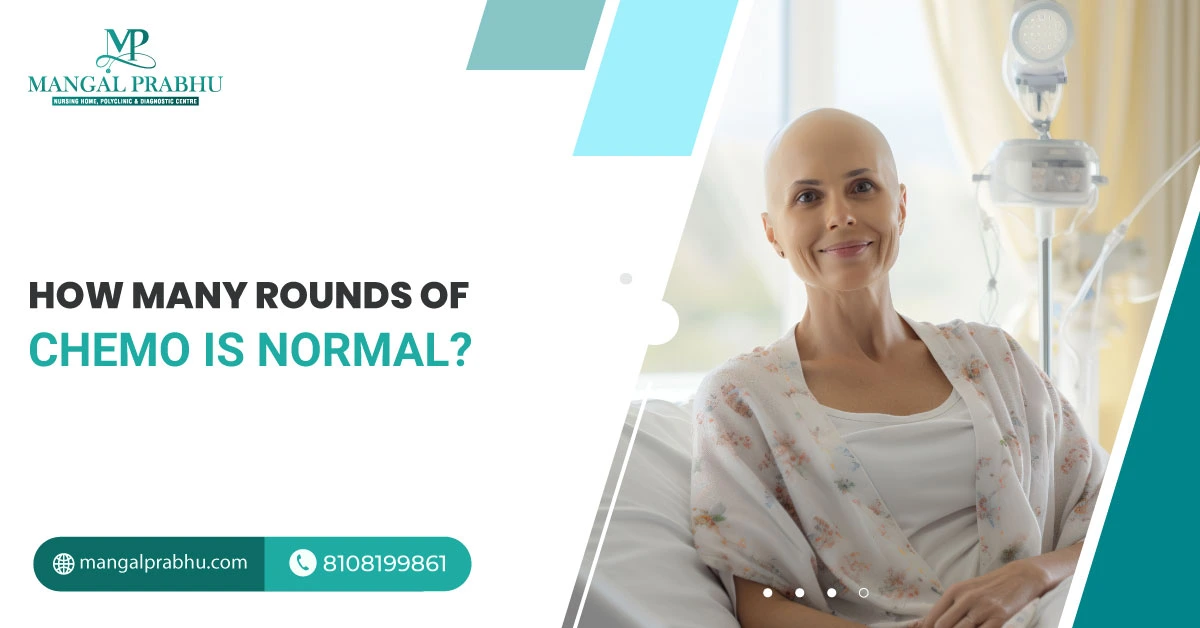
How Many Rounds of Chemo is Normal?
Chemotherapy is one of the effective treatments for many types of cancer. These drugs, combined with radiation therapy, immunotherapy, hormone therapy, and surgery, are administered to prevent cancer from spreading and growing. A cancer specialist in Navi Mumbai recommends chemotherapy in multiple cycles.
This is to ensure that your body gets enough rest before the next cycle begins. It also helps assess how your body and the cancer responds to the medication. In this article, we’ve discussed all you should know about factors affecting chemotherapy duration, how many rounds of chemo is normal, and the chemo cycles. Let’s take a look:
Factors Influencing the Number of Chemo Rounds
The number of chemo sessions you need depends on many factors:
i) Type of Cancer:
Breast and lung cancer, for example, require 4-6 cycles of chemotherapy. Chronic leukemia may require ongoing chemo sessions that can last up to 2 years.
ii) Stage of Cancer:
Cancer that’s diagnosed at an early stage might require fewer chemo rounds compared to the advanced-stage cancer that’s spreading aggressively. Your treatment plan may include chemo sessions before and after surgery.
iii) Patient’s Health:
How your body reacts to the chemo drugs determine the number of chemo rounds required. If your tumor shrinks and your symptoms improve, the oncologist may recommend fewer sessions. If the progress is slow, more rounds might be scheduled.
Typical Chemotherapy Schedules
A normal range for chemotherapy rounds is between 4 and 6 cycles, but as mentioned above, it can vary from patient to patient, depending on the type and stage of cancer. Usually, the sessions start with chemo drugs, which are administered over a few days and are followed by a rest period of 2-3 weeks before another chemo session is planned.
Experts advise that chemotherapy drugs must be given with a rest period, as these medications can kill your fast-growing healthy cells. It’s a common side-effect of chemotherapy. So, while the treatment works wonders for cancer patients by killing the rapidly multiplying cancer cells, it also affects the cells responsible for your hair growth, cells in your mouth, gut, and other places. Your body needs adequate time to replenish these healthy cells.
Individualized Treatment Plan
Treatment is mostly personalized based on the patient’s age, type of cancer, and its aggressiveness. If needed, the chemotherapy regimen can be changed. The doctor decides whether to continue or how the future sessions should be planned based on how your cancer responds to the first few cycles.
Managing Side Effects
The most common side-effects after chemotherapy include fatigue, sore mouth, hair loss, nausea, vomiting, diarrhea or constipation, neuro pain, cognitive issues, weight loss, and low immunity.
Chemotherapy treatment in Navi Mumbai is associated with many side-effects, some of which can cause extreme discomfort and might interfere with your daily activities. Talk to your doctor if the side-effects get severe. They will recommend lifestyle modification, change medication, or switch your chemo regimen to manage side-effects. There’s no exact chemotherapy count. You may need only a couple of sessions to kill cancer completely. Others may need more for the best results.
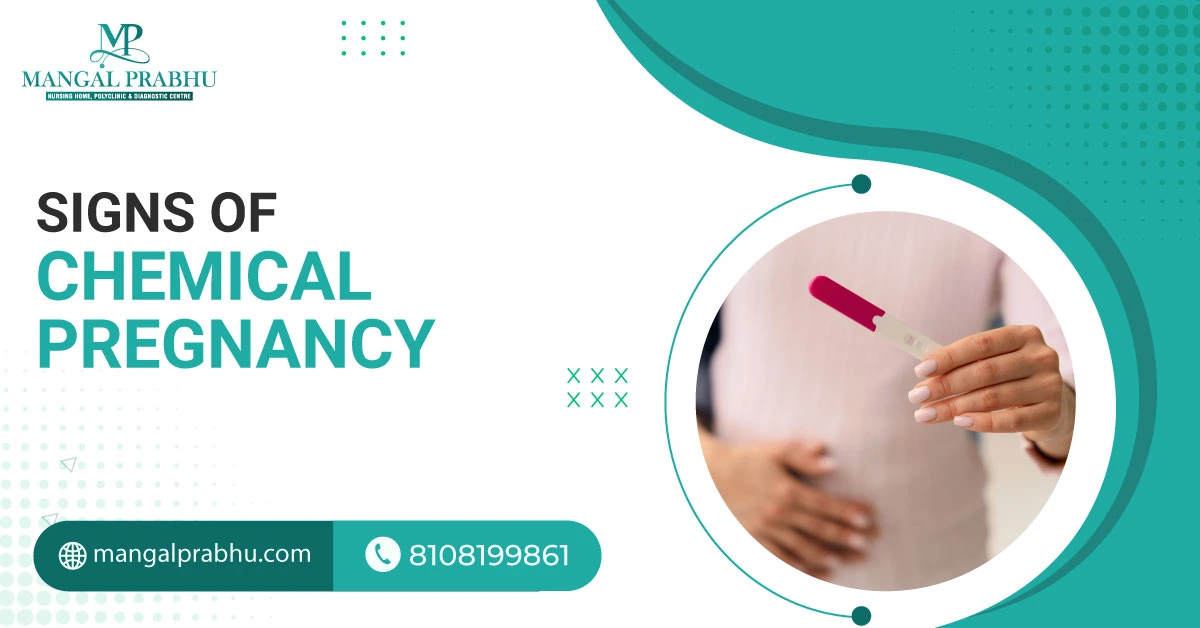
Signs of Chemical Pregnancy
Not every pregnancy is carried to term. A chemical pregnancy refers to an early miscarriage or termination of a pregnancy before five weeks. It’s so early that some women don’t even realize they are pregnant and had a miscarriage, especially if the pregnancy ends soon after the missed period. Chances are your pregnancy won’t be visible on the ultrasound.
It’s important to know the signs of chemical pregnancy and head to the nearest maternity hospital in Navi Mumbai if you experience the symptoms mentioned below:
Early Signs of Chemical Pregnancy
Chemical pregnancy can make you an emotional wreck. Having a miscarriage right after the positive pregnancy test is not just physically exhausting but is equally tough on your mental health. Here’s what to watch out for:
1) Bleeding:
It may start with spotting, which gradually develops into heavy period-like bleeding. Your period might arrive late.
2) Lower Abdominal Cramps:
When your pregnancy doesn’t progress, your body will start to shed the uterine lining, which results in mild cramping. It mimics your period cramps, so it’s often hard to tell whether it’s just the regular monthly cramps or pregnancy-loss cramps.
3) Drop in hCG Levels
Your hCG levels rise drastically in the first few weeks of your pregnancy. In the case of a chemical pregnancy, women notice faint lines on the pregnancy test, which might completely disappear as the hCG levels drop.
4) Pregnancy Test Results
The most obvious sign of a chemical pregnancy is the negative test result. If you have had a positive pregnancy test followed by a negative result, it may indicate an early pregnancy loss.
5) No Pregnancy Symptoms
For some women, pregnancy symptoms, such as nausea, vomiting, and breast tenderness, can start as early as 2-3 weeks. If you felt morning sickness, nausea, and other pregnancy-induced symptoms, which resolved suddenly, it may be a sign you have had a miscarriage.
6) Emotional Impact
For those who didn’t realize a pregnancy loss might go on to live their lives normally. Those who have taken a pregnancy test might be disheartened by a negative pregnancy report. As mentioned earlier, it can take a toll on your mental health.
However, know that it’s neither your nor your partner’s fault. Chemical pregnancies occur due to a defect in the chromosome makeup. If the fetus doesn’t get the right number of chromosomes, the pregnancy is highly likely to end quickly. The good news is that you can try immediately after a pregnancy loss, although doctors usually advise you to wait until your next period.
7) Medical Consultation
If you had a positive pregnancy test followed by a negative test, it’s a good idea to see an obstetrician and gynecologist in Navi Mumbai. It’s especially recommended for women who have had repeat miscarriages in the first few weeks of conception. The doctor will order tests and suggest the most suitable treatment.
Conclusion
Do not feel hopeless if you’ve had a chemical pregnancy. There’s still a good chance you can have a healthy and viable pregnancy in the future. It’s, however, advisable to see a gynecologist to rule out any health issues.
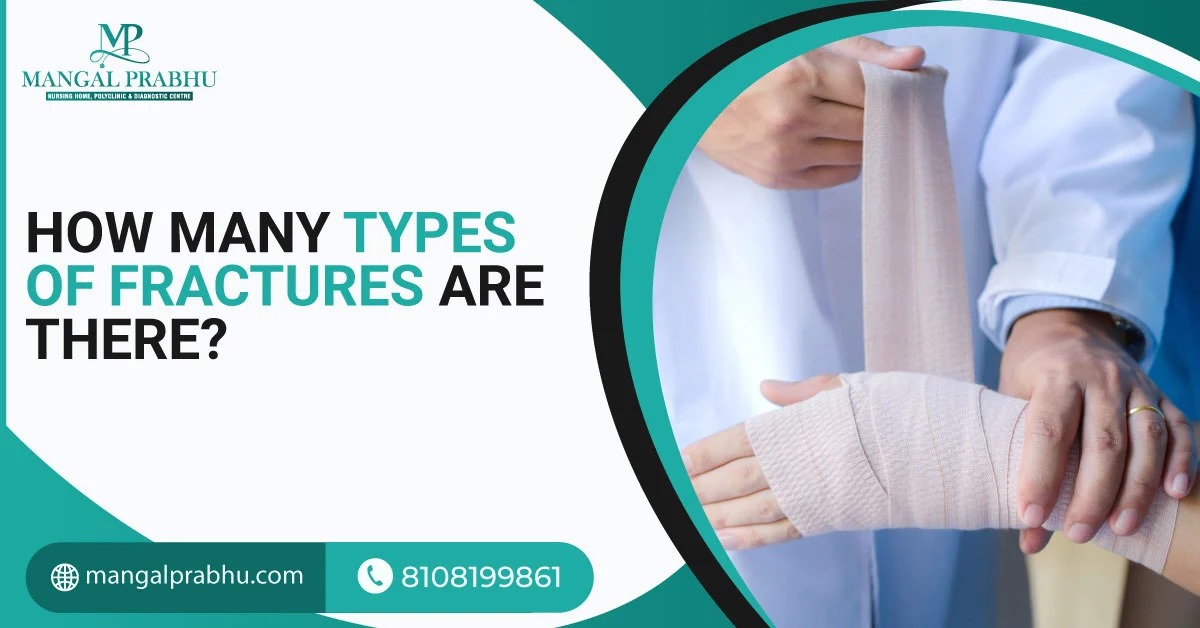
How Many Types of Fractures Are There?
Your bone density tends to decrease with age, increasing the risk of bone fracture. A bone fracture occurs when a heavy object hits your bones with a force greater than the bone can bear. The fracture can be minor; the bone may crack but doesn’t break completely. This can be fixed with casting and splinting. Or, it can be severe enough to break through the skin, increasing the risk of infection and other complications. In either case, it’s important to seek fracture treatment in Navi Mumbai to get your bones realigned. Read on to find out how many types of fractures are there.
Major Types of Fractures
a) Simple/Closed Fractures:
The bones break inside your skin but do not pierce through the skin. These are less complicated and often get better with immobilization and casting.
b) Compound/Open Fractures:
In a compound fracture, the bone fragments are visible on your skin. It creates a deep wound that requires immediate medical attention. You must see an orthopedic surgeon in Navi Mumbai to have it surgically repaired.
c) Greenstick Fractures:
Due to their increased bone flexibility, children are mainly affected by greenstick fractures. These occur when something hits their bones, breaking one side of the bone and bending the other.
d) Comminuted Fractures:
This is the worst type. The bones in comminuted fractures break into more than two pieces, often requiring a surgical repair. Because of their severity, comminuted fractures occur mostly during accidents and severe falls.
Specific Fracture Types
i) Transverse Fractures:
A transverse fracture results in the bone breaking horizontally into two pieces. It’s common in your leg or forearm bones. Treatment requires splints or surgery, depending on the severity of the damage.
ii) Oblique Fractures:
A sudden trauma to the bone can cause it to break diagonally. Oblique fractures are common in athletes, as they twist their arms and legs often during sports.
iii) Spiral Fractures:
Bones can also break spirally. Like oblique fractures, spiral fractures are common in people who forcefully twist their bones.
iv) Impacted Fractures:
Impacted fractures result in one end of the bone pushing into another due to serious trauma to the bones. These fractures can affect your ankles, hips, arms, and wrists. Since the bones do not break into pieces, you have a certain level of stability. That, however, doesn’t mean your bones are aligned. Treatment is required to restore your bones to their normal position.
Special Cases
A) Stress Fractures:
A fracture might occur from repetitive activities that put pressure on your bones. These are called stress fractures.
B) Pathologic Fractures:
These fractures occur because of a medical condition that can result in bone weakening to a degree that even a minor trauma can cause a severe fracture.
Prevention and Recovery
You can’t prevent situations, such as accidents or falls, that can lead to bone fractures. Here are a few tips that can help reduce your risk:
- Eat a diet rich in vitamin D and calcium
- Exercise regularly
- Resolve underlying medical conditions, such as osteoporosis.
Conclusion
Fractures are common during accidents and falls. Although anyone can get their bone fractured, people with low bone density are at an increased risk.

Effective Strategies in the Medical Management of Breast Cancer
Breast cancer diagnosis can be emotionally and physically challenging. However, advancements in technology and medical science have improved the survival rate and quality of life of many cancer patients. Depending on the stage of the cancer, breast cancer treatment in Navi Mumbai may involve surgery as a standalone procedure or combined with chemotherapy, radiation therapy, and hormone therapy.
In this post, we’ve explored some effective strategies in the medical management of breast cancer. Keep reading.
Early Detection and Diagnosis
The 5-year survival rate of women with breast cancer is 99% if it’s localized, i.e., if it hasn’t spread to the surrounding tissues and lymph nodes. The same is 86% for patients with regional breast cancer and 31% if it’s distant or has spread outside the breast tissue.
Screening Methods
Your health professional will conduct a thorough breast examination to detect any visible lumps that could be cancerous. They will also look at your breasts to check if your nipples and breasts look normal. Here’s what else can be used for detecting breast cancer.
1) Mammogram:
This is a type of breast X-ray that examines both breasts closely. If the mammogram shows anything unusual, another one will be ordered. This gives a detailed look at your breast tissues.
2) An Ultrasound:
Your healthcare provider may recommend a breast ultrasound, which can differentiate between a fluid-filled cyst and a cancerous mass. The doctors will decide whether further screening is needed depending on the test result.
3) MRI:
For an MRI, the patient is injected with the dye that gives a clear picture of both your breasts. This imaging test is used to detect how far the cancer has spread.
4) Biopsy:
A small sample of the breast tissues is used to detect cancerous growth.
Treatment Options
Your oncologist in Navi Mumbai might recommend the following treatment options:
a) Surgery
For most types of early-stage breast cancers, surgery is the most effective option. It’s possible to remove the tumor completely. This will prevent the likelihood of the cancer recurring. The surgery is called lumpectomy. If the tumor is large, a mastectomy (complete or partial removal of the breasts) might be needed.
b) Chemotherapy and Radiation Therapies
Chemotherapy can be given before surgery to shrink the tumor size, making it operable. It could be needed after surgery, as well. If cancer has spread beyond the breasts and has entered lymph nodes and nearby organs, chemotherapy, and radiation therapies followed by tumor removal are recommended.
c) Targeted Therapies
A targeted therapy attacks cancer cells by destroying the chemical mechanism in these cells. These are highly effective and have fewer side effects, as targeted therapies cause minimal damage to healthy cells. Most targeted therapies destroy the cancer cells that make extra HER2 (a protein responsible for the growth of cancer in your body).
d) Immunotherapy
Immunotherapy can be used for triple-negative breast cancer. The therapy signals your immune system to find and kill cancer cells. These treatment options are often used together to destroy cancer cells, slow their growth, and remove the mass from your breasts.
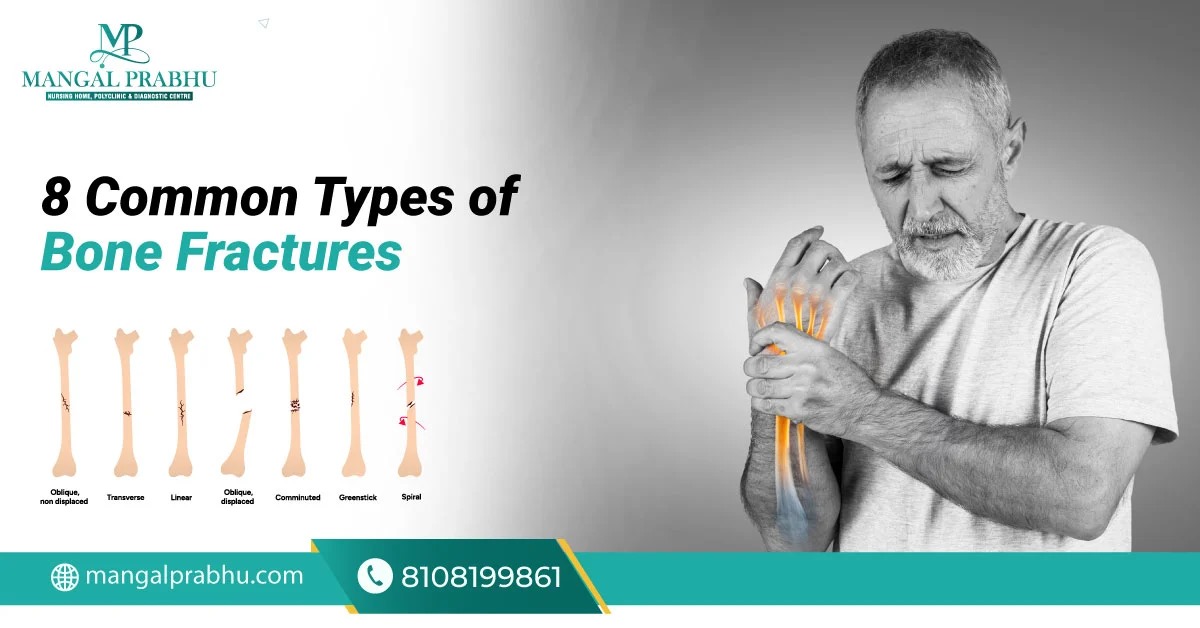
8 Types of Bone Fractures
Bone fracture refers to the broken or cracked bones. Although anyone at any age can experience a bone fracture, they are more common in older people (above 50 years). The risk is higher in people diagnosed with osteoporosis. Visit an orthopedic hospital in Navi Mumbai for bone density screening. The test detects weak and brittle bones and also suggests your likelihood of getting bone fractures. In the meantime, let’s explore the eight most common types of bone fractures.
8 Types of Bone Fractures
1) Simple Fracture
A simple fracture occurs when the bone breaks but does not cause any visible injury on the skin or break through your skin. There’s no severe tissue damage, as the bone is contained within your body. The bone might slightly displace or remain completely aligned with little damage to the soft tissue. Rest and immobilization are the most effective treatment options for simple fractures.
2) Compound Fractures
A compound fracture is more severe than a simple fracture. It occurs when the bone breaks and pierces your skin, leading to a severe wound. It’s caused by a fall from a great height or a car accident that puts excessive force on your bones, causing them to break and injure your skin. You will notice the bone sticking out of your skin and severe bleeding. See an orthopedic doctor in Navi Mumbai immediately if you notice these signs.
3) Comminuted Fractures
A car crash or other severe accident can result in your bone getting broken into many pieces. It’s another serious type of bone crack that requires hospitalization. The treatment for comminuted bone fractures is a surgical repair. The broken bones can take a year or longer to heal completely.
4) Greenstick Fractures
In greenstick fractures, your bone bends so much that it cracks slightly but does not break into multiple pieces. They result from sports injuries, falls, and other kinds of trauma. They are common in children, as children’s bones are weaker compared to adults.
5) Transverse Fractures
A transverse fracture is a bone crack that goes straight across the bone. It looks like a horizontal cut. The crack occurs from a fall or a heavy object hitting your bone. Immobilization is usually recommended for transverse fracture, but surgery might be needed if the bones’ alignment is affected.
6) Oblique Fractures
An oblique fracture is a diagonal crack, usually found in the long bones. These also occur from trauma to your bone due to a fall or an accident.
7) Spiral Fractures
Spiral fractures occur due to a sudden twisting motion, especially during strenuous physical activities or sports. These look like a corkscrew, a spiral line that goes all the way around the bone.
8) Compression Fractures
Compression fractures occur in the vertebra in your spine. They are most common in people with osteoporosis or a weakened spine, which is likely to collapse if you experience a fall, injury, or any accident that hits your spinal area.
Conclusion
Bone fractures are common and mostly occur because of trauma to your bones. These are more common in people with weaker bones (especially elders) than healthy ones. Treatment includes immobilization and surgery in severe cases.
